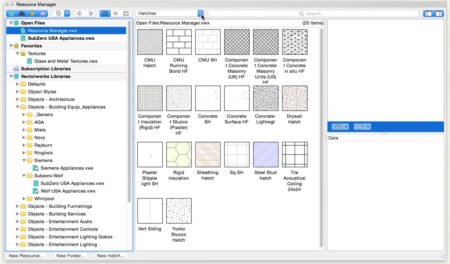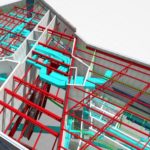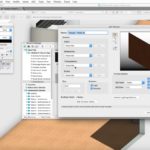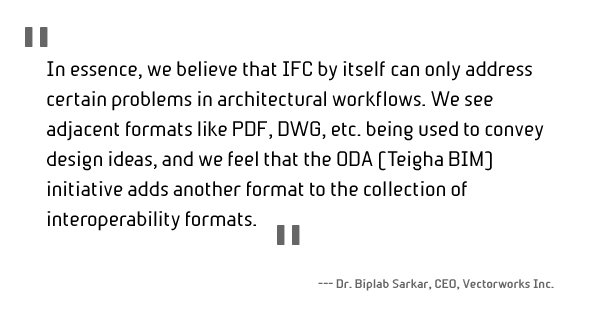Every release in a major CAD product tends to have one primary feature that the company put a lot of time into. In Vectorworks 2017, that feature is undoubtedly the new Resource Manager, and it’s one of the features that recently appointed Vectorworks CEO, Dr. Biplab Sarkar, is most proud.
“It took nearly ten man years to develop the new Resource Manager,” says Sarkar, “and the work involved coordination between ours and the Sofia office.” Mentioning the Bulgarian office, suggests that the company is developing larger multi-office, transatlantic development strategies.
The new Resource Manager is indeed a large change in Vectorworks 2017. For starters, it replaces what was previously known as the Resource Browser. The name change correctly suggests that “management” of project resources is the real purpose of the tool palette, and this was taken to heart on multiple levels.

01 – The new Resource Manager above indicating the “filter” drop-down above the central window. The left area is for navigation to resources—including cloud and network locations—the center section shows resources, and the right section shows graphical preview and data behind each resource.
Unlike the old Resource Browser, the new Resource Manager gains a much larger and integrated palette window. Navigation, results, search, and object data are all defined in clear zones. It is strikingly different than what it replaces but instantly learnable. “You can tag your resources,” says Sarkar, “and search by tag.” While such 21st-century knowledge management software techniques are cool and useful, back at the Vectorworks Design Summit in the spring of 2016, what wowed the crowd was the ability to customize file organization of resources by folder.
The new Resource Browser also shows for the first time how the company can leverage its Vectorworks Service Select online subscription services from within the program in an elegant way, and this will no doubt point the way of other future aspects of Vectorworks, and how cloud services can tie into the software user experience.
Data Visualization—Raising the Specter of Seeing BIM Data Heuristically
Earlier in the year at AIA, Architosh noted that the movers and shakers in the BIM software industry were doing things with “data” in often novel ways. A few years ago the “I” in BIM was as sexy as an IFC specification. In other words—terribly unsexy. But this message in the market was not lost on the folks at Vectorworks and in version 2017 they have introduced new ways of seeing BIM data graphically. The results are often heuristic, allowing architects to discover or gain insights about their building designs as well as graphically clarifying concepts.
“With data visualization, you have this system of records [in Vectorworks] where you can attach these records to objects. The values in the records or the range of the records can then be graphically clarified in different viewports,” says Dr. Sarkar. For example, records attached to doors can include fire rating in minutes. This range of values in the records can be graphically portrayed using colors, for example, to enable a viewport of a plan that calls attention graphically to these fire door ratings. “This also applies to ‘spaces’ and the record values associated with those spaces,” says Dr. Sarkar. “That’s a big evolution from where we were.”
Democratizing Cloud Services and Renderworks
Vectorworks Cloud Services have now been opened up to everyone, a big change from the previous subscriber-only philosophy. Dr. Sarkar explained why the dramatic change was implemented. “Our users, particularly the architects, wanted to share their models with the general contractors. And, it’s not just contractors to architects but all kinds of stakeholders for various users of Vectorworks, who have a compelling reason to gain access to the models,” says Sarkar. “And you don’t need to be a Vectorworks user,” he adds, “because now you can login using Google or Facebook accounts.”

02 – Vectorworks Architect 2017 adds IFC 4 support, the latest industry- standard OPEN BIM interoperability format.

03 – Renderworks is now included in all Vectorworks versions. A new feature is Cinema 4D texture import which greatly enhances visual quality capacity for Vectorworks 2017.
Opening up Cloud Services also means that stakeholders like clients can access and view Vectorworks models using the Vectorworks Nomad mobile application as well. The app gives stakeholders who travel with iPads, for example, rather than laptop computers, a convenient way to stay connected to collaboration workflows.
Also in version 2017, the company decided to open up Renderworks; it is no longer a separate product called “Renderworks” but rather fully integrated into every version of Vectorworks. This means that even with Vectorworks Fundamentals, users have access to the award-winning Cinema 4D render engine.
Advancing BIM in Vectorworks
If readers recall our coverage of the Vectorworks Design Summit back in the spring, then you learned about Dr. Sarkar’s bolder visions to advance Vectorworks as a leading BIM application worthy of competition with all the leading BIM applications, including Revit, ArchiCAD, and Bentley’s AECOsim. New advances in Vectorworks Architect 2017 include notable new capabilities with features such as the new Slab Drainage Tool and new Door and Window Styles. With the latter, parametric doors and windows can now have a Style associated with them. For each parametric element of the door or window, it can be set to “by Style” or “by Instance” thereby giving the user graduated control over Styles. The net result is that hundreds of windows, for example, can be edited all at once across a range of attributes (such as sash dimensions, frame size, et cetera) while still maintaining “by instance” controls, such as various sill conditions, as in the case when the same window is placed into different types of walls.
Another major advancement for BIM users is the new Structural Objects tools. It will be much easier for architects to model in structural elements like steel beams and explore complicated arrangements and formations using these elements. Yet, perhaps the most powerful new BIM tool is the new Slab Drain tool, which dramatically automates the complex process of setting proper drainage slopes for flat roofs. The way this tool works is you insert drain locations within a “slab” object. From new settings with palette options, users can set properties for drainage, default elevation levels, and slopes and can even set these as slab styles to streamline change management. “The new Slab Drainage tool has been a long-time request of power users,” says Dr. Sarkar, indicating that in general over 70 percent of new features in each new release are coming from meeting the demands of users. “As a company,” adds Sarkar, “we are extremely customer driven.”
While there are a myriad of other new features affecting the BIM workflow—such as the new Railing and Fence tool for stairs and guardrails and the new Interior Elevations tools which automate the process of setting up viewports for interiors views—Vectorworks Architect 2017 comes loaded with a dramatic AEC industry first in its new native Revit Import support. Developed by the Open Design Alliance and its members, the new Revit import capabilities come about due to the adoption of the ODA’s Teigha BIM 1.0 libraries as part of its API offerings.
Advertisement
Vectorworks 2017 can now import in native Revit files and Revit family file formats. This means, for example, architects can import ductwork and mechanical BIM geometry models directly from their HVAC consultant if she is using Autodesk Revit products, rather than go through an open industry format and conversion process. This shouldn’t, however, be seen as a change of heart towards the OPEN BIM movement. “In essence, we believe that IFC by itself can only address certain problems in architectural workflows,” says Dr. Sarkar. “We see adjacent formats like PDF, DWG, etc. being used to convey design ideas, and we feel that the ODA [Teigha BIM] initiative adds another format to the collection of interoperability formats.”
In fact, while the new Revit import support will help BIM workflows for Vectorworks 2017 users, particularly access to product BIM models by building products manufacturers and other architectural users, Vectorworks Architect 2017 continues to advance its commitments to buildingSMART and the Open BIM industry initiatives. New is support for BIM Collaboration Format (BCF) which is another open industry format for interoperable collaboration in the AEC industry. BCF enables software tools to create snapshots of BIM models and their attendant issues, with notes, revision markings, and highlighted issues all packaged into a deliverable that can open up inside any other BCF capable BIM tool.
Finally, it should also be mentioned that Vectorworks Architect 2017 has full support for IFC 4, the latest open industry standard for interoperability of BIM software orchestrated by buildingSMART.
next page: Of Speed and Algorithms—VGM and Marionette






Reader Comments
https://t.co/hcZCSyscFR — Vectorworks 2017 ramps up BIM capacities, 10-man-years of development supercharges just… https://t.co/SeiPTMGr07
https://t.co/hcZCSyscFR — Vectorworks 2017 ramps up BIM capacities, 10-man-years of development supercharges just… https://t.co/SeiPTMGr07
[…] next page: Of Speed and Algorithms—VGM and Marionette […]
Details Behind Development of New Vectorworks 2017 Software > the management of project resources… https://t.co/8Gt0V4JhVX
RT @randydeutsch: Details Behind Development of New Vectorworks 2017 Software > the management of project resources https://t.co/rqsGuWTxxV…
Details Behind Development of New Vectorworks 2017 Software > the management of project resources… https://t.co/8Gt0V4JhVX
RT @randydeutsch: Details Behind Development of New Vectorworks 2017 Software > the management of project resources https://t.co/rqsGuWTxxV…
RT @randydeutsch: Details Behind Development of New Vectorworks 2017 Software > the management of project resources https://t.co/rqsGuWTxxV…
RT @randydeutsch: Details Behind Development of New Vectorworks 2017 Software > the management of project resources https://t.co/rqsGuWTxxV…
Details Behind Development of New #Vectorworks2017 Software https://t.co/qRQhx0mPia
Details Behind Development of New #Vectorworks2017 Software https://t.co/qRQhx0mPia
Dr. Sarkar Reveals Details Behind Development of New @Vectorworks 2017 Software https://t.co/An6Z9ehAM8 by Anthony Frausto-Robledo #aec
Dr. Sarkar Reveals Details Behind Development of New @Vectorworks 2017 Software https://t.co/An6Z9ehAM8 by Anthony Frausto-Robledo #aec
Comments are closed.